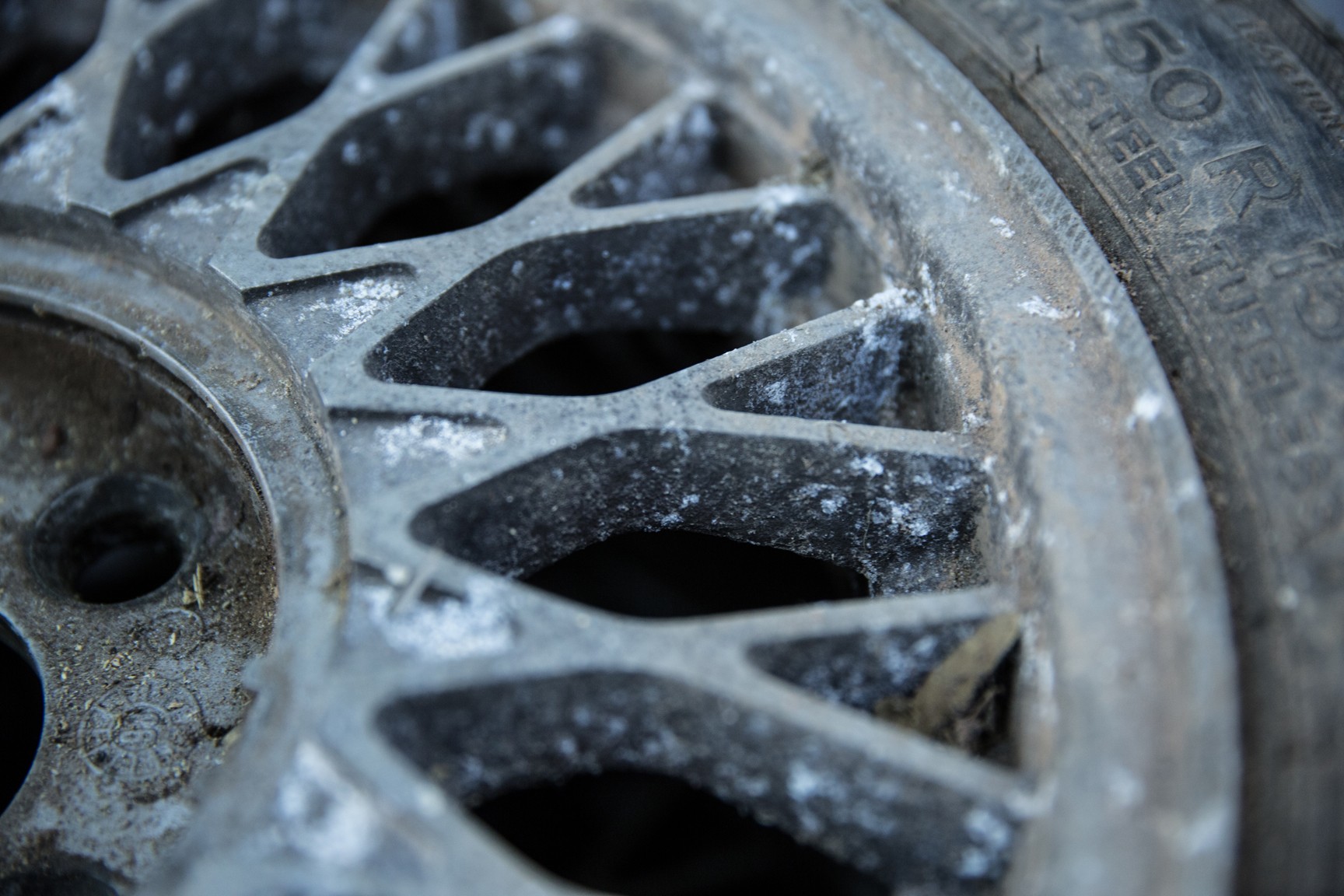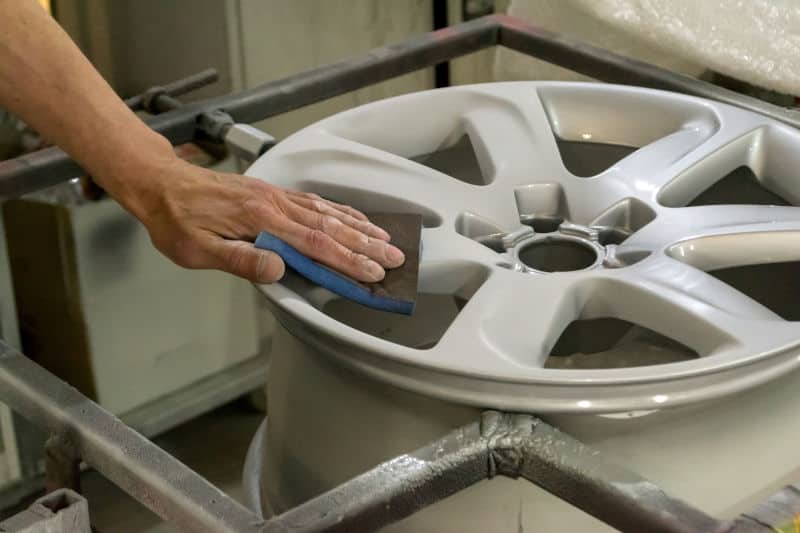How to remove corrosion from aluminum wheels – Aluminum wheels, a common sight on modern vehicles, are susceptible to corrosion, a process that can degrade their appearance and compromise their structural integrity. This degradation, often caused by exposure to harsh elements like salt, road grime, and harsh weather conditions, can manifest in various forms, including pitting, white rust, and galvanic corrosion. Understanding the causes and types of corrosion is essential for effectively removing it and restoring the pristine look of your wheels.
This guide will delve into the intricacies of aluminum corrosion, providing a comprehensive understanding of the underlying chemical reactions and the factors that contribute to its formation. We will then explore a range of methods for removing corrosion, from commercial cleaners and DIY solutions to more specialized techniques like electrolysis and sandblasting. Finally, we will discuss preventative measures to protect your aluminum wheels from future corrosion, ensuring their longevity and aesthetic appeal.
Understanding Aluminum Corrosion

Aluminum is a highly reactive metal, meaning it readily interacts with its surroundings. When exposed to air, aluminum forms a thin, protective oxide layer that shields the metal from further corrosion. This oxide layer is called aluminum oxide (Al2O3), and it is remarkably stable and resistant to further oxidation. However, this protective layer can be compromised under certain conditions, leading to corrosion of the aluminum.
Causes of Aluminum Corrosion
The protective oxide layer on aluminum can be damaged by various factors, leading to corrosion. Here are some common causes of corrosion on aluminum wheels:
- Exposure to Salt: Salt, particularly road salt used during winter months, is highly corrosive to aluminum. It breaks down the protective oxide layer, exposing the underlying metal to further corrosion. The salt dissolves in water, forming a conductive solution that accelerates the corrosion process.
- Road Grime and Debris: Road grime, a mixture of dirt, oil, and other contaminants, can also contribute to aluminum corrosion. These substances can trap moisture against the wheel surface, creating an environment conducive to corrosion.
- Harsh Weather Conditions: Extreme temperatures, humidity, and exposure to UV radiation can also damage the protective oxide layer on aluminum wheels. These factors can weaken the layer, making it more susceptible to corrosion.
Types of Aluminum Corrosion
Different types of corrosion can affect aluminum wheels, each with its unique characteristics and appearance. Here are some common types:
- Pitting: Pitting corrosion is characterized by the formation of small, localized holes or pits on the aluminum surface. It occurs when the protective oxide layer is damaged, allowing the aluminum to react with the environment. The pits can grow over time, eventually weakening the metal.
- White Rust: White rust, also known as aluminum oxide hydrate, is a form of corrosion that appears as a white, powdery deposit on the aluminum surface. It forms when aluminum is exposed to high humidity or moisture, and it is often found on wheels stored in humid environments.
- Galvanic Corrosion: Galvanic corrosion occurs when two dissimilar metals are in contact with each other in the presence of an electrolyte, such as saltwater. Aluminum is often used in conjunction with other metals, such as steel, in vehicle components. When these metals come into contact, the aluminum can act as the anode and corrode, while the other metal acts as the cathode and remains relatively protected.
Assessing the Severity of Corrosion
Before attempting to remove corrosion from your aluminum wheels, it’s crucial to assess the severity of the damage. This will help you determine the most appropriate cleaning method and whether professional intervention is required.
Visual Inspection
A thorough visual inspection is the first step in assessing the severity of corrosion. Look for the following signs:
- Surface Corrosion: This is the most common type of corrosion and appears as a white, powdery coating on the surface of the aluminum. It can be easily removed with a cleaning solution.
- Pitting: This type of corrosion is more severe and appears as small holes or depressions in the surface of the aluminum. It can be difficult to remove and may require professional intervention.
- Discoloration: Aluminum can also become discolored due to corrosion. This discoloration may be a sign of deeper corrosion.
Using a Wire Brush or Sandpaper
Once you’ve visually inspected the wheels, you can use a wire brush or sandpaper to determine the extent of the corrosion and the presence of underlying damage.
- Wire Brush: A wire brush can be used to remove loose corrosion and reveal the underlying metal. If the corrosion is deep, the wire brush may not be able to remove it completely.
- Sandpaper: Sandpaper can be used to smooth out the surface of the aluminum and remove any remaining corrosion. However, it’s important to use sandpaper with caution, as it can damage the aluminum if used too aggressively.
Determining the Appropriate Cleaning Method
The severity of the corrosion will determine the appropriate cleaning method.
- Mild Corrosion: Mild corrosion can be removed with a cleaning solution or a wire brush.
- Moderate Corrosion: Moderate corrosion may require a more aggressive cleaning method, such as using a chemical stripper or sandblasting.
- Severe Corrosion: Severe corrosion may require professional intervention. In some cases, the wheels may need to be replaced.
Cleaning Methods for Aluminum Wheels: How To Remove Corrosion From Aluminum Wheels

Cleaning aluminum wheels is crucial for maintaining their appearance and preventing further corrosion. Various methods are available, each with its pros and cons, and choosing the right approach depends on the severity of the corrosion and your desired outcome.
Methods for Cleaning Aluminum Wheels
A comparison of different cleaning methods for aluminum wheels is provided below.
| Method | Description | Pros | Cons |
|---|---|---|---|
| Commercial Cleaners | These cleaners are specifically formulated to remove corrosion and grime from aluminum wheels. They often contain acidic or alkaline ingredients that break down the corrosion layer. | Effective in removing light to moderate corrosion, readily available, and relatively easy to use. | Can be harsh on the aluminum surface if not used properly, may require multiple applications for stubborn corrosion, and some can be expensive. |
| DIY Solutions | These solutions use common household ingredients like vinegar, baking soda, or lemon juice to remove corrosion. | Cost-effective, environmentally friendly, and generally safe to use. | Less effective than commercial cleaners for severe corrosion, may require more time and effort, and the results may be inconsistent. |
| Electrolysis | This method uses an electrolytic process to remove corrosion by passing an electric current through a solution containing the corroded aluminum wheel. | Highly effective in removing even severe corrosion, relatively safe when done correctly, and can restore the aluminum to its original condition. | Requires specialized equipment and knowledge, can be time-consuming, and may not be suitable for all types of corrosion. |
| Sandblasting | This method uses compressed air to blast abrasive particles onto the aluminum surface, removing corrosion and creating a smooth finish. | Very effective in removing severe corrosion, can create a uniform finish, and can be used to prepare the surface for painting or powder coating. | Can damage the aluminum surface if not done properly, requires specialized equipment and expertise, and can be noisy and dusty. |
Safety Precautions for Cleaning Aluminum Wheels
When cleaning aluminum wheels, it’s crucial to prioritize safety.
- Always wear protective gear, including gloves, eye protection, and a respirator, especially when using harsh chemicals or abrasive materials.
- Work in a well-ventilated area to avoid inhaling fumes or dust.
- Avoid using abrasive cleaners or scrubbers on the aluminum surface, as these can damage the finish.
- Use a soft cloth or sponge to apply cleaning solutions and avoid using metal tools that can scratch the aluminum.
- Rinse the wheels thoroughly with clean water after cleaning to remove any remaining cleaning agents.
Importance of Rinsing
Rinsing the wheels thoroughly after cleaning is crucial for several reasons.
- Removes cleaning agents that can leave streaks or residue on the aluminum surface.
- Prevents the cleaning agents from reacting with the aluminum, which can cause further corrosion.
- Ensures the wheels are clean and ready for a protective coating, such as wax or sealant.
Preventing Future Corrosion

Once you’ve successfully removed corrosion from your aluminum wheels, the next step is to protect them from future damage. This involves applying a protective coating and practicing regular maintenance to minimize exposure to corrosive elements.
Protective Coatings for Aluminum Wheels, How to remove corrosion from aluminum wheels
Applying a protective coating to your aluminum wheels creates a barrier between the metal and the elements, preventing corrosion and enhancing their appearance. Several types of coatings are available, each offering different levels of protection and requiring specific application methods.
| Coating Type | Application Method | Durability | Maintenance |
|---|---|---|---|
| Wax | Applied by hand or with a machine | Provides short-term protection, typically lasting a few weeks | Requires frequent reapplication, usually after every wash |
| Sealant | Applied by hand or with a machine | Offers longer-lasting protection than wax, typically lasting several months | Requires periodic reapplication, typically every few months |
| Ceramic Coating | Applied by a professional detailer | Provides the most durable protection, lasting for several years | Requires minimal maintenance, typically just a wash and sealant application once a year |
| Powder Coating | Applied professionally in a specialized facility | Offers extremely durable protection, lasting for years and resisting scratches and chips | Requires minimal maintenance, typically just a wash and sealant application once a year |
Regular Maintenance
Washing your wheels frequently removes dirt, grime, and corrosive elements, preventing them from building up and causing damage. After each wash, applying a protectant like wax or sealant creates an additional layer of protection. This routine helps maintain the shine of your wheels and prevents corrosion from forming.
Minimizing Exposure to Corrosive Elements
To further protect your aluminum wheels, minimize their exposure to corrosive elements. This includes avoiding driving in salty conditions, as the salt can accelerate corrosion. Parking your car in a covered area also helps protect your wheels from the elements.
By understanding the causes, identifying the type of corrosion, and applying appropriate cleaning methods, you can effectively remove corrosion from your aluminum wheels. Remember, prevention is key. Regular maintenance, including washing the wheels frequently and using a protectant after each wash, can significantly reduce the risk of corrosion. Additionally, minimizing exposure to corrosive elements, such as avoiding driving in salty conditions and parking in covered areas, will help preserve the beauty and integrity of your aluminum wheels for years to come.
FAQ
What are the best commercial cleaners for aluminum wheels?
There are many effective commercial cleaners available, but some popular choices include Mothers Mag & Aluminum Polish, Meguiar’s NXT Tech Wax, and Chemical Guys Wheel & Tire Cleaner.
Can I use vinegar to remove corrosion from aluminum wheels?
Vinegar can be used as a mild cleaning agent, but it may not be effective against severe corrosion. It’s best to use a dedicated aluminum wheel cleaner.
How often should I clean my aluminum wheels?
It’s recommended to clean your aluminum wheels at least once a month, or more frequently if you drive in harsh conditions.
What are the signs of severe corrosion on aluminum wheels?
Severe corrosion is characterized by deep pitting, flaking paint, and visible signs of metal deterioration. If you notice these signs, it’s best to consult a professional for repair.